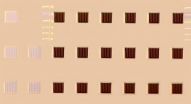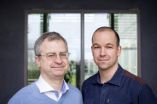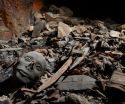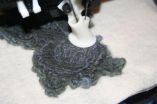(Press-News.org) BOSTON – Inherited mutations in the BRCA1 or BRCA2 tumor suppressor genes are by far the most frequent contributors to hereditary cancer risk in the human population, often causing breast or ovarian cancer in young women of child-bearing age. Attempts to test the role that the BRCA genes play in regulating a repair process associated with genome duplication have proven frustratingly difficult in living mammalian cells.
Now investigators at Beth Israel Deaconess Medical Center (BIDMC) report a new mechanism by which BRCA gene loss may accelerate cancer-promoting chromosome rearrangements. The new findings explain how the loss of BRCA1 or BRCA2 function impairs homologous recombination (HR), a normally accurate repair process used to fix DNA breaks, and actually stimulates faulty error-prone HR repair.
Described online in the April 28 issue of the journal Nature, the discovery could ultimately provide clinicians with valuable new information to help them ascertain risk and guide patient treatment when faced with BRCA mutations of uncertain significance, and offers a potentially valuable new tool for the development of cancer therapeutics.
"Mutations in the BRCA genes cause breast and ovarian cancers that affect thousands of women throughout the U.S. and around the world, often striking them in the prime of life," says senior author Ralph Scully, MB BS, PhD, a leader in the Breast Cancer Oncology program in BIDMC's Cancer Center and Associate Professor of Medicine at Harvard Medical School. "For almost two decades, scientists have been striving to better understand the tumor suppressor functions of BRCA1 and BRCA2."
Potentially harmful breaks in DNA strands commonly occur during DNA replication, a prerequisite to cell division. These breaks occur when the replication fork that duplicates the genome stalls at sites of DNA damage. If not properly repaired, the breaks can promote genomic instability, leading to cancer and other diseases.
"Some years ago, we and others suggested that BRCA1 and BRCA2 regulate homologous recombination at sites of stalled replication," explains Scully. "We believe that this function is critical to how these genes suppress breast and ovarian cancer. Until now, we haven't had the tools necessary to study in molecular detail the HR processes at sites of replication fork stalling in the chromosomes of a living mammalian cell."
To solve this problem, first author Nicholas Willis, PhD, a postdoctoral fellow in the Scully laboratory, created a new tool by harnessing a protein-DNA complex that evolved in bacteria.
"We found that the Escherichia coli (E. coli) Tus/Ter complex can be engineered to induce site-specific replication fork stalling and chromosomal HR in mouse cells," explains Willis. "In its essence, E coli bacteria – a standard model organism in science – has evolved a very simple system to arrest replication forks in a site-specific manner." This system, he explains, is composed of short DNA elements called Ter sites, 21-23 base pairs in length and tightly bound by the protein Tus. "Tus binds these Ter elements with extremely high affinity and, upon replication fork approach, acts as a barrier to fork progression along the DNA. Tus/Ter effectively sets up a 'road block' and stalls the replication fork."
The acid test for the new tool, say the authors, came when this same short Ter sequence was placed into a reporter, a slightly larger DNA sequence that can undergo certain rearrangements within a chromosome when triggered to do so. "When it engaged in homologous recombination, a change in the sequence caused the cells to express green fluorescent protein," explains Willis. "When the cells glowed green, we knew we had a positive event."
As he goes on to explain, the team adapted the reporter to distinguish between error-free/high-fidelity HR and an error-prone/aberrant form of HR. "Remarkably, when we studied cells lacking BRCA1 or BRCA2, we found that the frequency of aberrant HR events triggered at Tus/Ter-stalled replication forks had actually increased compared to normal cells. We knew at this point that we had discovered a new and important process by which BRCA gene loss promotes cancer."
The discovery provides a promising bridge between basic science and the clinic, says Scully. "Sometimes a genetic sequencing test reveals a mutation in BRCA1 or BRCA2 that has not been definitively associated with cancer," he explains. Often described as "Variants of Uncertain Significance" (VUS), these mutations are not found in high enough frequency in healthy women or in women with breast or ovarian cancers to allow the specific BRCA1 or BRCA2 mutations to be reliably classified as high risk or low risk. This is an important issue since a woman with a known high-risk BRCA gene mutation may elect to undergo potentially lifesaving prophylactic mastectomy or oophorectomy, as Scully further explains.
"There is a growing appreciation that careful measurement of the HR functions of BRCA1 and BRCA2 VUS mutants might help to classify them into high risk or low risk groups," he notes. "It would be gratifying if our system could contribute new information to help ongoing efforts to classify these VUS mutants."
Furthermore, he adds, understanding the mechanisms that regulate HR at stalled replication forks might hold additional promise for the development of novel cancer therapeutics. "If we could use this tool to help develop new cancer therapies, it would be a grand slam," says Scully. "This new system might also be useful in genome editing, which is considered groundbreaking technology used for the development of new gene therapies."
INFORMATION:
In addition to Scully and Willis, coauthors include Gurushankar Chandramouly, Bin Huang, Amy Kwok, Cindy Follonier and Chuxia Deng.
This study was funded, in part, by NIH grants R01CA095175, R01GM073894, R21CA144017, and R37GM26938; by NIH/NCI postdoctoral fellowship 5T32CA081156; and by ACS postdoctoral fellowship PF-12-248-01-DMC.
Beth Israel Deaconess Medical Center is a patient care, teaching and research affiliate of Harvard Medical School, and currently ranks third in National Institutes of Health funding among independent hospitals nationwide.
The BIDMC health care team includes Beth Israel Deaconess Hospital-Milton, Beth Israel Deaconess Hospital-Needham, Beth Israel Deaconess Hospital-Plymouth, Anna Jaques Hospital, Cambridge Health Alliance, Lawrence General Hospital, Signature Health Care, Commonwealth Hematology-Oncology, Beth Israel Deaconess HealthCare, Community Care Alliance, and Atrius Health. BIDMC is also clinically affiliated with the Joslin Diabetes Center and Hebrew Senior Life and is a research partner of Dana-Farber/Harvard Cancer Center. BIDMC is the official hospital of the Boston Red Sox. For more information, visit http://www.bidmc.org.
Researchers identify mechanism of cancer caused by loss of BRCA1 and BRCA2 gene function
Study elucidates the BRCA genes' tumor suppressor functions and could help guide treatment in mutations of uncertain signficance
2014-04-28
ELSE PRESS RELEASES FROM THIS DATE:
Multilayer, microscale solar cells enable ultrahigh efficiency power generation
2014-04-28
Researchers at the University of Illinois at Urbana-Champaign use a printing process to assemble tiny cells into multilayer stacks for extraordinary levels of photovoltaic conversion efficiency.
As an energy source, the Sun has always been a dependable provider. Although it freely shines on everyone, the ability to capture and convert the Sun's abundant energy is anything but free. However, new technologies aimed at achieving "full spectrum" operation in utility-scale photovoltaics may soon make solar energy a viable option.
"A few simple ideas in materials science ...
Overlooked cells hold keys to brain organization and disease, UCSF study shows
2014-04-28
Scientists studying brain diseases may need to look beyond nerve cells and start paying attention to the star-shaped cells known as "astrocytes," because they play specialized roles in the development and maintenance of nerve circuits and may contribute to a wide range of disorders, according to a new study by UC San Francisco researchers.
In a study published online April 28, 2014 in Nature, the researchers report that malfunctioning astrocytes might contribute to neurodegenerative disorders such as Lou Gehrig's disease (ALS), and perhaps even to developmental disorders ...
Loss of Y chromosome can explain shorter life expectancy and higher cancer risk for men
2014-04-28
It is generally well known that men have an overall shorter life expectancy compared to women. A recent study, led by Uppsala University researchers, shows a correlation between a loss of the Y chromosome in blood cells and both a shorter life span and higher mortality from cancer in other organs.
Men have a shorter average life span than women and both the incidence and mortality in cancer is higher in men than in women. However, the mechanisms and possible risk factors behind this sex-disparity are largely unknown. Alterations in DNA of normal cells accumulate throughout ...
Extremes in wet, dry spells increasing for South Asian monsoons, Stanford scholars say
2014-04-28
Stanford scientists have identified significant changes in the patterns of extreme wet and dry events that are increasing the risk of drought and flood in central India, one of the most densely populated regions on Earth.
The discoveries, detailed in the April 28 issue of the journal Nature Climate Change, are the result of a new collaboration between climate scientists and statisticians that focused on utilizing statistical methods for analyzing rare geophysical events. These new approaches reveal that the intensity of extremely wet spells and the number of extremely ...
Indiana University researchers gauge the toll of trampoline fractures on children
2014-04-28
INDIANAPOLIS -- Trampoline accidents sent an estimated 288,876 people, most of them children, to hospital emergency departments with broken bones from 2002 to 2011, at a cost of more than $400 million, according to an analysis by researchers at the Indiana University School of Medicine.
Including all injuries, not just fractures, hospital emergency rooms received more than 1 million visits from people injured in trampoline accidents during those 10 years, boosting the emergency room bills to just over $1 billion, according to the study.
The research, published online ...
Urbanization, higher temperatures can influence butterfly emergence patterns
2014-04-28
An international team of researchers has found that a subset of common butterfly species are emerging later than usual in urban areas located in warmer regions, raising questions about how the insects respond to significant increases in temperature.
"We know that butterflies emerge earlier in North Carolina than they do in New England, because it's warmer," says Tyson Wepprich, a Ph.D. student at NC State and co-author of a paper describing the work. "We also know that cities are heat sinks that are warmer than outlying areas. So we wanted to see whether butterflies would ...
Basel Egyptologists identify tomb of royal children
2014-04-28
Who had the privilege to spend eternal life next to the pharaoh? Close to the royal tombs in the Egyptian Valley of the Kings, excavations by Egyptologists from the University of Basel have identified the burial place of several children as well as other family members of two pharaohs.
Basel Egyptologists of the University of Basel Kings' Valley Project have been working on tomb KV 40 in the Valley of the Kings close to the city of Luxor for three years. From the outside, only a depression in the ground indicated the presence of a subterranean tomb. Up to now, nothing ...
Criminal behavior: Older siblings strongly sway younger siblings close in age
2014-04-28
If a sibling commits a violent criminal act, the risk that a younger sibling may follow in their footsteps is more likely than the transmission of that behavior to an older sibling, according to a new study conducted by researchers at Virginia Commonwealth University and Lund University in Sweden.
The findings provide insight into the social transmission of violent behaviors and suggest that environmental factors within families can be important when it comes to delinquent behavior. Down the road, the results may be used to inform strategies for prevention and treatment ...
Research shows smartphone sensors leave trackable fingerprints
2014-04-28
Research at the University of Illinois has demonstrated that smartphone sensors — not just the ones meant to track your location — can leave real-time fingerprints unique to each individual device. An attacker could use such sensor data from a given smartphone to identify it ever after, almost making the user-trackable.
Research by Electrical and Computer Engineering Associate Professor Romit Roy Choudhury and graduate students Sanorita Dey and Nirupam Roy, demonstrated that these fingerprints exist within smartphone sensors, mainly because of imperfections during the ...
Carnegie Mellon-Disney researcher invents 3D printing technique for making cuddly stuff
2014-04-28
PITTSBURGH—Soft and cuddly aren't words used to describe the plastic or metal things typically produced by today's 3D printers. But a new type of printer developed by Carnegie Mellon University and Disney Research Pittsburgh can turn wool and wool blend yarns into fabric objects that people might actually enjoy touching.
The device looks something like a cross between a 3D printer and a sewing machine and produces 3D objects made of a form of loose felt. Scott Hudson, a professor in CMU's Human-Computer Interaction Institute who developed the felting printer with Disney ...
LAST 30 PRESS RELEASES:
Tracing the quick synthesis of an industrially important catalyst
New software sheds light on cancer’s hidden genetic networks
UT Health San Antonio awarded $3 million in CPRIT grants to bolster cancer research and prevention efforts in South Texas
Third symposium spotlights global challenge of new contaminants in China’s fight against pollution
From straw to soil harmony: International team reveals how biochar supercharges carbon-smart farming
Myeloma: How AI is redrawing the map of cancer care
Manhattan E. Charurat, Ph.D., MHS invested as the Homer and Martha Gudelsky Distinguished Professor in Medicine at the University of Maryland School of Medicine
Insilico Medicine’s Pharma.AI Q4 Winter Launch Recap: Revolutionizing drug discovery with cutting-edge AI innovations, accelerating the path to pharmaceutical superintelligence
Nanoplastics have diet-dependent impacts on digestive system health
Brain neuron death occurs throughout life and increases with age, a natural human protein drug may halt neuron death in Alzheimer’s disease
SPIE and CLP announce the recipients of the 2025 Advanced Photonics Young Innovator Award
Lessons from the Caldor Fire’s Christmas Valley ‘Miracle’
Ant societies rose by trading individual protection for collective power
Research reveals how ancient viral DNA shapes early embryonic development
A molecular gatekeeper that controls protein synthesis
New ‘cloaking device’ concept to shield sensitive tech from magnetic fields
Researchers show impact of mountain building and climate change on alpine biodiversity
Study models the transition from Neanderthals to modern humans in Europe
University of Phoenix College of Doctoral Studies releases white paper on AI-driven skilling to reduce burnout and restore worker autonomy
AIs fail at the game of visual “telephone”
The levers for a sustainable food system
Potential changes in US homelessness by ending federal support for housing first programs
Vulnerability of large language models to prompt injection when providing medical advice
Researchers develop new system for high-energy-density, long-life, multi-electron transfer bromine-based flow batteries
Ending federal support for housing first programs could increase U.S. homelessness by 5% in one year, new JAMA study finds
New research uncovers molecular ‘safety switch’ shielding cancers from immune attack
Bacteria resisting viral infection can still sink carbon to ocean floor
Younger biological age may increase depression risk in older women during COVID-19
Bharat Innovates 2026 National Basecamp Showcases India’s Most Promising Deep-Tech Ventures
Here’s what determines whether your income level rises or falls
[Press-News.org] Researchers identify mechanism of cancer caused by loss of BRCA1 and BRCA2 gene functionStudy elucidates the BRCA genes' tumor suppressor functions and could help guide treatment in mutations of uncertain signficance






